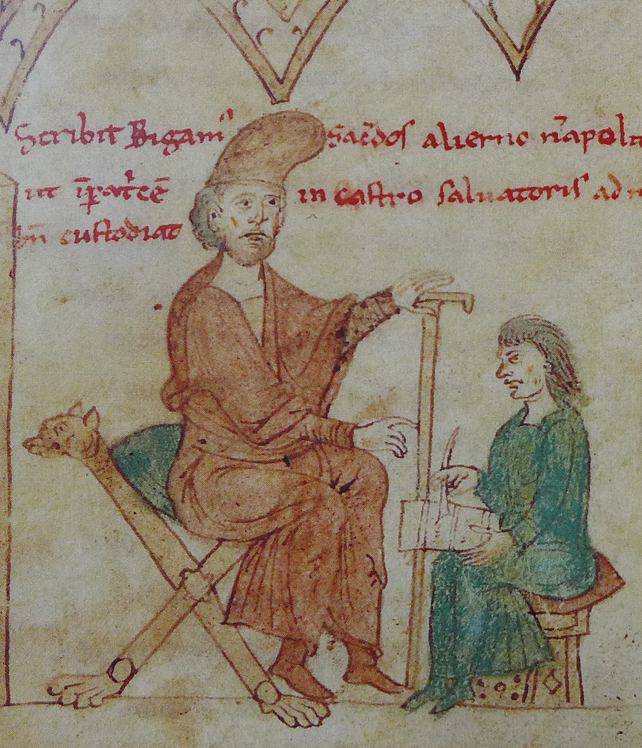|
Caïd Richard
Richard the Qaid () was a senior official ('' qāʾid'', commander) of the royal council ('' curia regis'' or '' diwan'') in the court of the Norman Kingdom of Sicily at Palermo during the latter years of the reign of William I of Sicily and during the regency of his wife, Margaret of Navarre, for their son William II. He was already the Great Chamberlain, or ''magister camerarius'', when William I died in 1166. Origin Richard was a Muslim convert to Christianity, and likely a eunuch. He possibly appears in the records of the royal council in January 1161, but he rose to prominence in the political affairs of the day only in 1166. Career during the regency for William II Appointment as master chamberlain and ''familiaris regis'' In that year, King William I died on 17 May, leaving his underage son William II on the throne, under the regency of the Queen-mother, and advised by a council of three ''familiares regis'' under the leadership of Peter the Qaid. Although in effective cont ... [...More Info...] [...Related Items...] OR: [Wikipedia] [Google] [Baidu] |
Qāʾid
Qaid ( ', "commander"; pl. ', or '), also spelled kaid or caïd, is a word meaning "commander" or "leader." It was a title in the Norman kingdom of Sicily, applied to palatine officials and members of the ''curia'', usually to those who were Muslims or converts to Islam. The word entered the Latin language as ''gaitus'' or ''gaytus''. Later the word was used in North Africa for the governor of a fortress or the warden of a prison, also in Spain and Portugal in the form with the definite article "alcayde" or "alcaide". It is also used as a male Arabic given name. Notable qaids * Al-Qaid Jawhar (active 950–992), A Slavic general who conquered the Maghreb and Egypt for the Fatimid Caliphate. *Al-Qa'id al-Bata'ihi, chief of staff and successor of al-Afdal Shahanshah as vizier of the Fatimid Caliphate. *Thomas Brun (active 1137–1154), Englishman who served Roger II of Sicily. * Ahmed es-Sikeli, known as Caid Peter (active 1160s), eunuch in the court of Sicily, confidant of Ma ... [...More Info...] [...Related Items...] OR: [Wikipedia] [Google] [Baidu] |
Archbishop Of Palermo
The Metropolitan Archdiocese of Palermo () is a Latin diocese of the Catholic Church. It was founded as the Diocese of Palermo in the first century and raised to the status of archdiocese in the 11th century."Archdiocese of Palermo" '' Catholic-Hierarchy.org''. David M. Cheney. Retrieved February 29, 2016"Metropolitan Archdiocese of Palermo" ''GCatholic.org''. Gabriel Chow. Retrieved February 29, 2016 The archbishop is Corrado Lorefic ... [...More Info...] [...Related Items...] OR: [Wikipedia] [Google] [Baidu] |
Ibn Qalaqis
Abu ʾl-Fatḥ Naṣr Allāh ibn ʿAbd Allāh (; 1137–1172), known as Ibn Qalāqis (or Ḳalāḳis) and also al-Qāḍī al-aʿazz ("he most honorable judge"), was an Egyptian Arab poet and author. He spent his last few years travelling widely through Sicily and Yemen. The collections of poems and letters he left behind contain much valuable information for historians. Life Ibn Qalaqis was born in 532 AH (1137 AD) in Alexandria, then part of the Fatimid Caliphate. He moved to Cairo for his education, and studied under Abu Tahir al-Silafi. In 1165/6, he wrote to the Sicilian ''qāʾid'' Abu'l-Qasim ibn Hammud ibn al-Hajar, requesting financial assistance for his ''ḥajj'' (pilgrimage) to Mecca. He met with difficulties in Egypt and never went, instead accepting Abu'l-Qasim's invitation to come to the island of Sicily, then part of the Norman Kingdom, but retaining a vibrant Arab culture. He arrived in Messina on 11 May 1168 and stayed on the island at least until April ... [...More Info...] [...Related Items...] OR: [Wikipedia] [Google] [Baidu] |
Walter Ophamil
Walter Ophamil or Offamil (fl. 1160–1191), italianised as Gualtiero Offamiglio or Offamilio from Latin ''Ophamilius'', was the archdeacon of Cefalù, dean of Agrigento, and archbishop of Palermo (1168–1191), called "''il primo ministro''", the first minister of the crown. He came to Sicily with Peter of Blois and Stephen du Perche at the direction of Rotrou, Archbishop of Rouen, cousin of Queen Margaret of Navarre, originally as a tutor to the royal children of William I of Sicily and Margaret. His mother was Bona, a patron of the Abbey of Cluny and a ''devota et fidelis nostra'' of the king in 1172. His father is unknown. From his name he was long thought to be an Englishman ("Walter of the Mill") but this interpretation is now rejected in favour of ''ophamilius'' referring to Walter as William II's ''protofamiliaris'', the senior confidant of the king in his royal household, the '' familiaris regis''. Biography Walter's first appearance in the historical record ... [...More Info...] [...Related Items...] OR: [Wikipedia] [Google] [Baidu] |
Matthew Of Salerno
Matthew of Ajello () was a high-ranking member of the Norman court of the Kingdom of Sicily in the 12th century. His brother John was a bishop. Career He first appears as the notary of the Admiral Maio of Bari who drew up the Treaty of Benevento of 1156. He rose to prominence in the next reign, that of William II of Sicily, becoming first grand protonotary and then chancellor. Maio groomed Matthew to be his successor and, it was alleged, even used him to get permission from Pope Alexander III in Rome for Maio to succeed William I in 1159. On 10 November 1160, Matthew warned Maio of an impending assassination attempt, but to no avail. While Matthew escaped, Maio was killed by Matthew Bonnellus. In 1162, Matthew interceded to prevent the William I from sacking Salerno. On William's death, he became foremost among the advisors of the queen regent, Margaret of Navarre. After the rebellions of the later years of William's reign, Matthew compiled from memory a vast catalogue of re ... [...More Info...] [...Related Items...] OR: [Wikipedia] [Google] [Baidu] |
